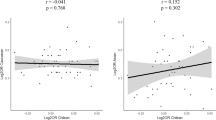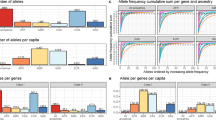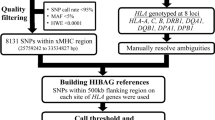Abstract
The genetic association of the major histocompatibility complex (MHC) to rheumatoid arthritis risk has commonly been attributed to alleles in HLA-DRB1. However, debate persists about the identity of the causal variants in HLA-DRB1 and the presence of independent effects elsewhere in the MHC. Using existing genome-wide SNP data in 5,018 individuals with seropositive rheumatoid arthritis (cases) and 14,974 unaffected controls, we imputed and tested classical alleles and amino acid polymorphisms in HLA-A, HLA-B, HLA-C, HLA-DPA1, HLA-DPB1, HLA-DQA1, HLA-DQB1 and HLA-DRB1, as well as 3,117 SNPs across the MHC. Conditional and haplotype analyses identified that three amino acid positions (11, 71 and 74) in HLA-DRβ1 and single–amino-acid polymorphisms in HLA-B (at position 9) and HLA-DPβ1 (at position 9), which are all located in peptide-binding grooves, almost completely explain the MHC association to rheumatoid arthritis risk. This study shows how imputation of functional variation from large reference panels can help fine map association signals in the MHC.
This is a preview of subscription content, access via your institution
Access options
Subscribe to this journal
Receive 12 print issues and online access
$209.00 per year
only $17.42 per issue
Buy this article
- Purchase on Springer Link
- Instant access to full article PDF
Prices may be subject to local taxes which are calculated during checkout





Similar content being viewed by others
References
Isenberg, D. Oxford Textbook of Rheumatology, 1278 (Oxford University Press, Oxford, New York, USA, 2004).
Klareskog, L., Catrina, A.I. & Paget, S. Rheumatoid arthritis. Lancet 373, 659–672 (2009).
Ding, B. et al. Different patterns of associations with anti-citrullinated protein antibody-positive and anti-citrullinated protein antibody-negative rheumatoid arthritis in the extended major histocompatibility complex region. Arthritis Rheum. 60, 30–38 (2009).
van der Woude, D. et al. Quantitative heritability of anti-citrullinated protein antibody-positive and anti-citrullinated protein antibody-negative rheumatoid arthritis. Arthritis Rheum. 60, 916–923 (2009).
Gregersen, P.K., Silver, J. & Winchester, R.J. The shared epitope hypothesis. An approach to understanding the molecular genetics of susceptibility to rheumatoid arthritis. Arthritis Rheum. 30, 1205–1213 (1987).
Stastny, P. HLA-D and Ia antigens in rheumatoid arthritis and systemic lupus erythematosus. Arthritis Rheum. 21, S139–S143 (1978).
Reinsmoen, N.L. & Bach, F.H. Five HLA-D clusters associated with HLA-DR4. Hum. Immunol. 4, 249–258 (1982).
Vignal, C. et al. Genetic association of the major histocompatibility complex with rheumatoid arthritis implicates two non-DRB1 loci. Arthritis Rheum. 60, 53–62 (2009).
Lee, H.S. et al. Several regions in the major histocompatibility complex confer risk for anti-CCP-antibody positive rheumatoid arthritis, independent of the DRB1 locus. Mol. Med. 14, 293–300 (2008).
Newton, J.L., Harney, S.M., Wordsworth, B.P. & Brown, M.A. A review of the MHC genetics of rheumatoid arthritis. Genes Immun. 5, 151–157 (2004).
Jawaheer, D. et al. Dissecting the genetic complexity of the association between human leukocyte antigens and rheumatoid arthritis. Am. J. Hum. Genet. 71, 585–594 (2002).
de Bakker, P.I. et al. A high-resolution HLA and SNP haplotype map for disease association studies in the extended human MHC. Nat. Genet. 38, 1166–1172 (2006).
Stahl, E.A. et al. Genome-wide association study meta-analysis identifies seven new rheumatoid arthritis risk loci. Nat. Genet. 42, 508–514 (2010).
Brown, W.M. et al. Overview of the MHC fine mapping data. Diabetes Obes. Metab. 11 (suppl. 1), 2–7 (2009).
Pereyra, F. et al. The major genetic determinants of HIV-1 control affect HLA class I peptide presentation. Science 330, 1551–1557 (2010).
Price, A.L. et al. Principal components analysis corrects for stratification in genome-wide association studies. Nat. Genet. 38, 904–909 (2006).
van der Woude, D. et al. Protection against anti-citrullinated protein antibody-positive rheumatoid arthritis is predominantly associated with HLA-DRB1*1301: a meta-analysis of HLA-DRB1 associations with anti-citrullinated protein antibody-positive and anti-citrullinated protein antibody-negative rheumatoid arthritis in four European populations. Arthritis Rheum. 62, 1236–1245 (2010).
Freudenberg, J. et al. Genome-wide association study of rheumatoid arthritis in Koreans: population-specific loci as well as overlap with European susceptibility loci. Arthritis Rheum. 63, 884–893 (2011).
Lee, H.S. et al. Microsatellite typing for DRB1 alleles: application to the analysis of HLA associations with rheumatoid arthritis. Genes Immun. 7, 533–543 (2006).
Raychaudhuri, S. Recent advances in the genetics of rheumatoid arthritis. Curr. Opin. Rheumatol. 22, 109–118 (2010).
Zhernakova, A. et al. Meta-analysis of genome-wide association studies in celiac disease and rheumatoid arthritis identifies fourteen non-HLA shared loci. PLoS Genet. 7, e1002004 (2011).
Trowsdale, J. The MHC, disease and selection. Immunol. Lett. 137, 1–8 (2011).
Nejentsev, S. et al. Localization of type 1 diabetes susceptibility to the MHC class I genes HLA-B and HLA-A. Nature 450, 887–892 (2007).
Price, P. et al. The genetic basis for the association of the 8.1 ancestral haplotype (A1, B8, DR3) with multiple immunopathological diseases. Immunol. Rev. 167, 257–274 (1999).
Pettersen, E.F. et al. UCSF Chimera—a visualization system for exploratory research and analysis. J. Comput. Chem. 25, 1605–1612 (2004).
Arnett, F.C. et al. The American Rheumatism Association 1987 revised criteria for the classification of rheumatoid arthritis. Arthritis Rheum. 31, 315–324 (1988).
Power, C. & Elliott, J. Cohort profile: 1958 British birth cohort (National Child Development Study). Int. J. Epidemiol. 35, 34–41 (2006).
Browning, B.L. & Browning, S.R. A unified approach to genotype imputation and haplotype phase inference for large data sets of trios and unrelated individuals. Am. J. Hum. Genet. 84, 210–223 (2009).
Robinson, J. et al. The IMGT/HLA database. Nucleic Acids Res. 39, D1171–D1176 (2011).
Acknowledgements
We thank the Type 1 Diabetes Genetics Consortium and the Wellcome Trust Case Control Consortium for data access. We acknowledge use of the HLA genotyping data performed by the Juvenile Diabetes Research Foundation/Wellcome Trust Diabetes and Inflammation Laboratory on the British 1958 Birth Cohort DNA collection. This project is supported by grants from the US National Institutes of Health (K08AR055688 (S.R.), R01-AR44422 (P.K.G.), R01-AR057108 and U01-GM092691 (R.M.P.)), the Korea Healthcare Technology Research and Development Project (A102065 and A111218-11-GM01 (H.-S.L. and S.-C.B.)), the Burroughs Wellcome Fund (R.M.P.), the Arthritis Foundation (S.R.) and by the Eileen Ludwig Greenland Center for Rheumatoid Arthritis (P.K.G.).
Author information
Authors and Affiliations
Contributions
S.R. and P.I.W.d.B. conceptualized and coordinated the study, oversaw the statistical analyses and wrote the initial version of the manuscript. S.R., P.I.W.d.B., C.S., E.A.S., J.F. and X.J. conducted all the statistical analyses. H.-S.L., S.-C.B., L.A., L.P., L.K., J.W., K.A.S., R.M.P. and P.K.G. organized and contributed subject samples and collected genome-wide SNP data. S.-C.B., H.-S.L. and P.K.G. provided the classical HLA genotype data. All authors contributed to writing the final manuscript.
Corresponding authors
Ethics declarations
Competing interests
The authors declare no competing financial interests.
Supplementary information
Supplementary Text and Figures
Supplementary Figures 1 and 2, Supplementary Tables 1–3, 5, 6 and Supplementary Note. (PDF 1049 kb)
Supplementary Table 4
Association analysis of all MHC markers in the European RA meta-analysis. (XLS 2050 kb)
Rights and permissions
About this article
Cite this article
Raychaudhuri, S., Sandor, C., Stahl, E. et al. Five amino acids in three HLA proteins explain most of the association between MHC and seropositive rheumatoid arthritis. Nat Genet 44, 291–296 (2012). https://doi.org/10.1038/ng.1076
Received:
Accepted:
Published:
Issue Date:
DOI: https://doi.org/10.1038/ng.1076
This article is cited by
-
Carriers of HLA-DRB1*04:05 have a better clinical response to abatacept in rheumatoid arthritis
Scientific Reports (2023)
-
MHC-II dynamics are maintained in HLA-DR allotypes to ensure catalyzed peptide exchange
Nature Chemical Biology (2023)
-
Genome-wide exploratory analysis for NARAC dataset with preparation for haplotype block partitioning through minor allele frequency quality control viewpoint
Iran Journal of Computer Science (2023)
-
HLA-DRB1 haplotypes predict cardiovascular mortality in inflammatory polyarthritis independent of CRP and anti-CCP status
Arthritis Research & Therapy (2022)
-
Evaluation of tree-based statistical learning methods for constructing genetic risk scores
BMC Bioinformatics (2022)



